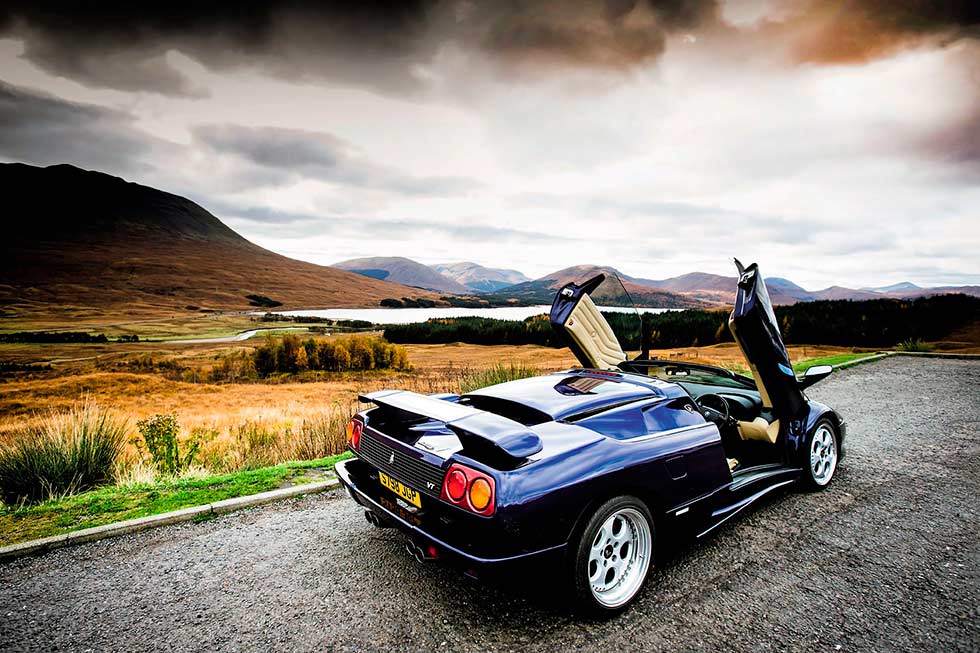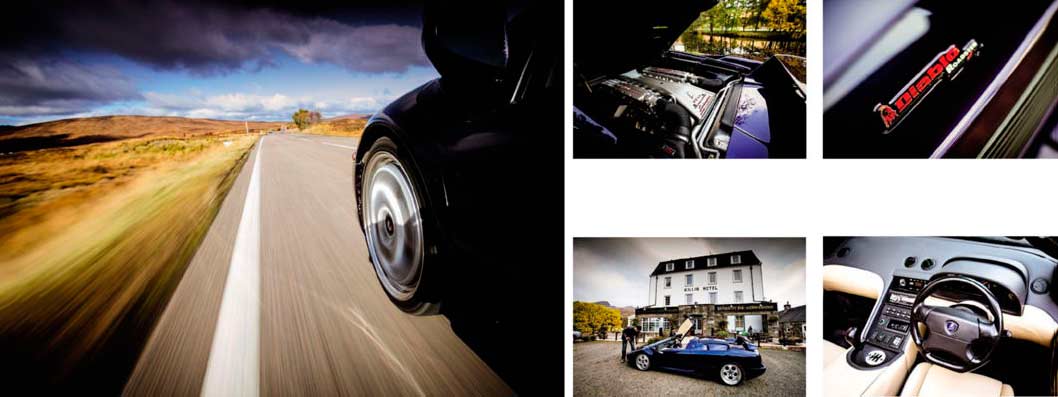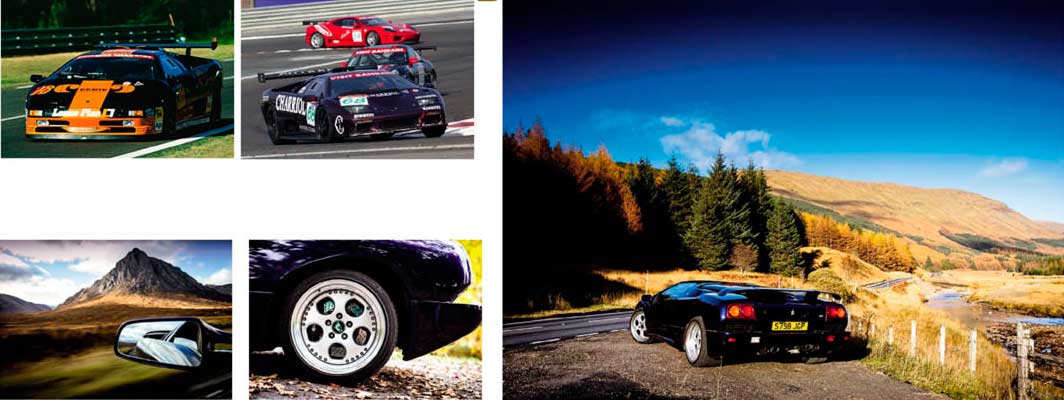
Lamborghini dream drive Highland fling in a Diablo. Lamborghini Diablo VT Scottish blast in the first production V12 roadster from Sant’Agata …with the sound of a V12 – unfettered by a roof in the wild Diablo VT Roadster. Monarch of the Glen. It took 30 years for Lamborghini to finally build a production V12 roadster. Ross Alkureishi takes the topless Diablo on a wild Highland adventure to find out whether it was worth the wait. Photography Malcolm Griffiths.
There are certain events in a man’s life that he never forgets: the playground spat with a bully; that first kiss; the birth of a child. Add to that the aural overkill as a Lamborghini Diablo’s V12 explodes into action. Never the most discreet of powerplants, Giotto Bizzarrini’s tour de force is currently doing its best to turn the other residents of The Killin Hotel into early morning curtain-twitchers.

The sight that greets them is otherworldly, a monstrous apparition of all that’s expected of a mid-1990s supercar: menacing, oversized presence; front-hinged scissor doors; a profusion of wings and air intakes; plus truly mammoth amounts of rubber. As the wedge-shaped gap above this machine’s rear engine lid indicates, however, this is no ‘ordinary’ Diablo. It’s a VT Roadster – well, more of a targa than a roadster, recalling the V8 Silhouette and Jalpa, and the first production car in three decades to fully liberate the 12-cylinder engine’s sonorous voice.
Whipping off the carbonfibre roof panel is a breeze – it weighs just 7kg. Locating it on top of the engine cover requires a little more care. Once it’s in place, you undertake that unique Lamborghini entrance limbo then activate an electro-pneumatic system that employs two pivots to securely clamp the panel. “It’s such a satisfying design,” says Carlo McCrindle, whose firm, Top Gear Specialist Cars, is selling this Roadster. “Why Lamborghini didn’t use it on the Murciélago is a mystery.”

The Diablo has traditionally been perceived as a particularly brutal piece of kit, but the cabin has an unexpectedly luxurious feel, with a profusion of the best leathers, thick carpets, air-con and electric windows; even the precision cut of the glass edges on the side windows scream class.
The steering column and seats are adjustable, with only the slightly sidesaddle driving position – caused by footwell intrusion and the subsequent offset pedal box – and impinged rear view hinting at supercar compromise. All very refined, and not at all what you expect.
A quick blip of the throttle instantly shatters any illusions of gentility – or emasculation – as the exhaust note thunders with intent around this ancient village. Such is the cacophony, I’m sure a few troubled souls have been stirred up in Finlarig Castle – the only one in Scotland with a beheading pit. It’s probably time to leave before we become personae non grata for our return to the hotel later in the day.
Pulling out on to the high street it’s immediately clear, at low speeds at least, that the Roadster is a remarkably civilised beast. The clutch is surprisingly light and obliging, plus the five-speed dogleg gearbox – a new design for the Diablo, to incorporate the transfer box for this four-wheel-drive version – shifts easily between cogs with satisfyingly mechanical resistance. The power-assisted steering is weighted to match your speed, so it’s easy even when manoeuvring – not something that could be said of the original two-wheel-drive cars.
Unveiled in Monte-Carlo in January 1990, and named Diablo after a particularly fierce 19th-century fighting bull, the Tipo 132 couldn’t afford to be anything other than spectacular in the extreme. After all, it had to follow in the trailblazing path of its Countach predecessor. Work began in early 1986, with the first prototype appearing three years later.

Lamborghini toyed with four-wheel drive at the development stage, but ditched the crude mechanical system due to reliability issues. Instead, traditional rear-wheel drive powered it to the title of Lamborghini’s first series-production car to top 200mph. Couple that emotive performance milestone with scintillating styling by Marcello Gandini – albeit somewhat softened by parent company Chrysler – plus a name that translated far and wide as ‘devil’, and its arrival caused quite a stir.
Under that dramatic skin, its spaceframe chassis was an evolution of the Countach’s construction, but featuring welded square tubes that simplified production and were 30% stiffer than the round-tube frame in torsion. Crumple zones were integrated front and rear, and the cockpit safety cell was constructed from high-strength steel. In addition, tougher alloys for the doors and the use of carbonfibre composites – for the central tunnel and body panels – worked together to improve safety.
The engineers at Sant’Agata fettled the ageing V12 to such an extent that it acquired a new type number, 521. Bore and stroke were increased to 87x80mm, the compression ratio upped to 10:1 and capacity to 5707cc, with electronic fuel injection – as introduced on later Federal-spec Countachs – and twin catalytic converters to keep a check on emissions. Still mounted longitudinally in the middle of the car, the V12’s aimed-for power hike to 460bhp was blitzed; instead, the stock car hit 492bhp at 7000rpm, with torque peaking at a thumping 428lb ft at 5200rpm – the latter a phenomenal 55% boost on the engine’s previous incarnation.

“It’s now perceived as a definitive ’90s supercar,” says McCrindle as we head west on the A85 towards Crianlarich, “but the early ones didn’t have a good image.” A lack of power assistance meant the steering was ponderously heavy at low speeds, plus the redesigned coil-sprung double-wishbone suspension remained somewhat connection between Gandini’s brilliant duo, thanks to the short nose/long tail combination, but the later car lacks the original’s handsome angularity. With roof panel in place, the VT looks uncomfortably cab-forward, but stowing it redresses this imbalance. At launch, the Diablo was criticised for size and heft, yet by modern supercar standards it’s average at worst.
The Roadster is claimed to be even stiffer than the closed version, which explains the complete lack of scuttle shake. The frame is reinforced in the A-pillars, sills and across the rear of the cockpit, with an integrated roll-over bar. Many panels – and the windscreen – are unique to the model, including engine cover, upper and lower air intakes, doors and rear bumper. Is it pretty? Who cares, the Diablo’s excessive silhouette is all about aggressive purpose. It wasn’t the company’s first attempt at an open-top V12 – Bertone’s dead-end Miura Roadster and the odd one-off appeared – but while rivals mined a rich seam in North America, Lamborghini went without.
We set off again, now comfortable enough with the vivid pace to take in some of our beautiful surroundings. Up here, you take your chances weather-wise, but we’re fortunate enough to see the clouds part and brilliant sunshine floods the cabin. The Diablo devours the long straits of Rannoch Moor with ravenous pleasure. The sun’s rays highlight the deep oranges of the wintry vegetation, and bounce off the myriad lochs, lochans, peat bogs and streams that illuminate this wilderness; there’s something perverse about traversing this enlightened landscape in a car named diablo, emitting a soundtrack forged by his minions.
No such worries in Glen Coe, scene of massacres and bloodshed through the ages. Formed from the remains of a supervolcano that erupted, the resultant Caldera – Spanish for cauldron – formation is foreboding even at the height of summer. Up towards the northern edge on Aonach Eagach lies the Devil’s Staircase, an old military route given its name by the soldiers building roads under General Wade, because Satan was said to put in an appearance to claim his own. Find yourself isolated up here and the environment can change in a flash, but there’s little danger today: horsepower has come a long way in the intervening centuries and all 492 of the Lamborghini’s power us through.

Just after Ballachullish we branch off on the A828 and loop round to follow the West Coast tourist route south, encountering only the remnants of the high season’s motorhome invasion. The brooding claustrophobia of the glens is suddenly released as the VT spears along this open coastal road. After the crossing at Loch Creran, the main road is left behind in favour of one of this area’s best-kept secrets: a loch-side route, sparingly used by locals and the odd Forestry Commission worker. It’s an undulating rollercoaster that runs along the eastern section through the Barcaldine Forest.
Here the Roadster is in its element. The steering is inspiring, but it’s the phenomenal level of traction that takes your breath away, along with the barrage of noise resonating through the trees. The suspension has anti-dive and antisquat geometry and, coupled with the VT of the title – which stands for Viscous Traction – it helps the Diablo to redefine the rules of the road. No longer are corners taken slow in/fast out, but fast in/even faster out. Once the preserve of fire-breathing rally machines and their roadgoing brethren, four-wheel drive was brought to the supercar world by Lamborghini. “It transformed the car’s drivability by taming the power,” says McCrindle. “You’d need to be a lunatic to get to its limits on a public road.”
The system, developed in conjunction with Steyr-Daimler-Puch, functions via a centre differential with a viscous coupling between front and rear axles. It’s pretty much rear-wheel-drive most of the time, with up to 29% of the power redirected to the front if traction is lost. But this technology, coupled with the open top, didn’t come cheap: at launch in 1993 a VT cost £162,000, with its Roadster sibling weighing in at £175,000, making it the most expensive model in the range. That’s £27k more than the 2wd cars and a full £50k ahead of the stripped-out SV, which soon became the ‘entry level’ Diablo.
After numerous runs alongside the loch, McCrindle takes the controls a little further on at Inverlochy and is soon pushing it along at a pulsating rhythm. The final journey back to Killin is an mesmerising drive on deserted tarmac. The Diablo handles each attack without a hint of pendulum effect, and with only reasonable air ingress into the cabin – although what it must be like at 200mph-plus is anyone’s guess.
Back at the hotel, with dinner out of the way, we feverishly retrace the day’s exertions over a couple of nips of Scotch. We retire to bed, but I can’t sleep. As soon as I close my eyes, I’m suddenly transported back to the glen, attacking every crest and corner in my mind’s eye, yet still barely uncovering the Diablo’s abilities. Wilder and more track-focused cars were to follow – as did a facelifted Roadster, with more power and faired-in headlights replacing the pop-ups – but that glorious open-top symphony means it’s too late for me. In my dreams, I’ve already sold my soul to this particular devil.
Thanks to Carlo McCrindle, Top Gear Specialist Cars (01501 763800; www.topgear-cars.co.uk); The Killin Hotel (www.killinhotel.com)
‘A BLIP OF THE THROTTLE SHATTERS ANY ILLUSIONS OF GENTILITY AS THE EXHAUSTTHUNDERS WITH INTENT’ ‘THERE’S SOMETHING PERVERSE TO TRAVERSING THIS ENLIGHTENED LANDSCAPE IN A CAR NAMED DIABLO’
Timeless jewel
If you require a masterpiece, employ a master. Lamborghini did just that when he commissioned freelancer Giotto Bizzarrini – of Alfa and Ferrari fame – to build a new engine. Based on similar lines to his earlier, stillborn 1.5-litre F1 V12 design, the oversquare 3.5-litre unit featured twin overhead cams and was more advanced than Ferrari’s then-current production engines. From traditional placement in the GT cars to transverse-mid installation in the Miura and longitudinale posteriore in the subsequent Countach, Diablo and Murciélago, it has proven its versatility and adaptability in a range of models. Capacity and power output grew from 3.5 litres and 300bhp in the original 350GT to 6.5 litres and an incredible 670bhp in its final Murciélago 670-4 SuperVeloce incarnation. Bizzarrini’s association with the firm may have ended in ’1963, but his legacy continued until 2010, thanks to this magnificent powerplant.
Hitting the track
Unlike his rivals, Ferruccio Lamborghini never saw the need to commit his company to racing. This neglected the fact that a competition arm that provided race preparation for privateers would have yielded some much-needed extra business. It wasn’t until 1996, when the production line had dwindled to one model – the Diablo – that it finally put rubber to track.
Developed for the Philippe Charriol Super Sport Trophy – part of the Global Endurance GT Series – the SVR (above right) featured a strengthened chassis, uprated suspension and brakes, wider wheels and a rollcage. Power rose to 550bhp and the predominantly amateur buyers also received a kit comprising safety gear, a new exhaust and a range of aerodynamic parts. The £175,000 price-tag included two seasons racing at various historic tracks, all running expenses plus accident repairs, and you got to keep the car at the end of it.
For ’1999 it evolved into the 590bhp GTR (right), which continued to compete in FIA GTs until well after the 2001 launch of the Murciélago.





